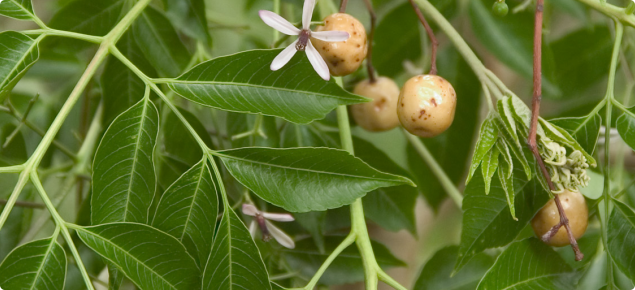| White cedar moth's voracious appetite can leave even the largest trees completely stripped of leaves. The hairy grubs can also cause health problems as some people suffer skin reactions after contact with the caterpillar’s hairs. |
Background
The cape lilac we have in Western Australia is Melia azedarach, which originated in the Himalaya region. Overseas it is called chinaberry or white cedar. It is closely related to the Australian form, Melia azedarach var. australasica, a native of New South Wales, Queensland and New Guinea, where it is more often called white cedar.
They are tough trees, and even complete defoliation causes only temporary stress, not death. The tree establishes very easily from seed, some spread by parrots — so many trees are chance seedlings. The golden berries, leaves, bark and flowers are very poisonous and smoke from burning wood contains toxic fumes.
Recent history
White cedar moths have become endemic, especially in the Perth metropolitan area, because of the high number and close proximity of cape lilac trees. The caterpillars tend to be particularly bad for one or two seasons until people undertake control measures.
Description and life cycle
The adult moth is grey-brown with a wingspan of over 40mm. It lays greyish coloured eggs in neat clusters, usually on the tree or in woodpiles. It is mostly active at night and can also lay eggs under shade cloth and behind curtains.
Eggs hatch as brown-black hairy caterpillars with a faint yellow body stripe. They quickly grow up to 40mm long, feeding at night and only on cape lilac trees. They are sensitive to sunlight and while small hide under bark and in hollows of the tree, usually on the southern side.
As they get larger, they come to ground at dawn, either by crawling down the trunk or by dropping down on a fine web. They are looking for shady hiding spots, new trees to feed on and places to pupate. The caterpillars move quickly, and can cover 60 to 80 metres or more in a short time. Many will return to the tree at dusk or just after, crawling up the trunk to feed on the leaves. This daily movement up and down the tree can continue for a week or more.
Caterpillars are active during the warmer months, and there can be from three to five generations, five to six weeks apart. Activity generally starts in October through to April, but it can begin as early as mid September.
Control
Like most insect pests, effective control is easiest early in their life cycle. Start control treatments in early October; or monitor for the pest weekly by shining a torch up into the canopy of the tree at dusk and start control measures at the first sign of activity.
Trunk banding
Loosely roll up some material like hessian, old curtain material or shade cloth, and tie it around the trunk of the tree to form a band or collar. Sprinkle an insecticidal dust onto this band. These dusts can also be applied to the trunk and around the base of the tree. Caterpillars crawling up or down the trunk will contact the chemical, especially those crawling into the band to hide during the day. The first application of dust should be quite heavy, then lightly topped up every seven days, or after rain. Maintain treatments until the onset of winter. Insecticidal dusts contain poison and should not be used near waterways.
Contact spraying
The caterpillars can be sprayed directly with garden or household insecticides. To achieve good control mix the chemical at the strongest label rate. Add a wetting agent, like a household detergent, at up to 10mL per litre to the mixture, otherwise it may not penetrate the hairy body. Spraying is best done at dawn or dusk when the caterpillars move together as a group. Also spray the butts of the trees, fencelines and areas where the pest is known to hide during the day, like leaf litter, woodpiles, compost bins, patios and under fence-capping.
Other measures
Chemical spray treatment of the cape lilac trees is usually impractical because of the size of the trees and the risk of spray drift. Organic preparations such as Bacillus thuringiensis applied to the leaves of smaller trees may have some effect on younger caterpillars.
If necessary apply surface sprays around doorways and windows to prevent caterpillars coming inside.

